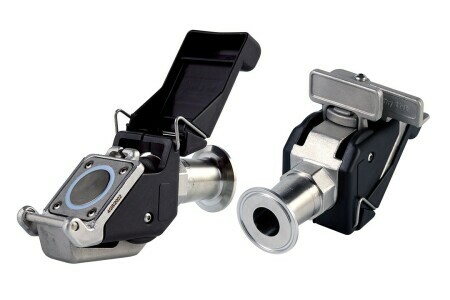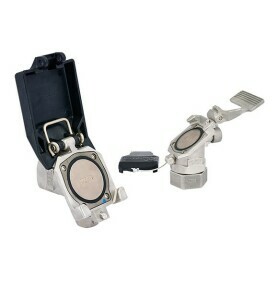Dry Link® Dry Disconnect Couplings
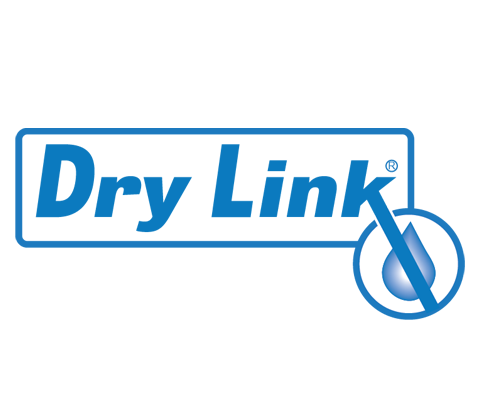
Maximize safety and efficiency in the bulk transfer of liquids and powders with Control Devices industry leading Dry Link® Dry Disconnect Couplings and high-containment split-butterfly valves.
Innovative Single-Handle Design for Quick, Secure Connections
Our patented design features a single handle that operates both the coupler and adapter valve simultaneously. The mechanical interlock ensures fast, secure connections while preventing accidental openings. Discs close and seal to prevent separation, guaranteeing spill-free operations every time.
Engineered to excel in demanding environments:
• Hazardous Material Handling
• High-Flow and High-Viscosity Fluids
• Sanitary and Ultra-Clean Transfers
Trusted Globally Across Industries
Leading chemical and petrochemical companies rely on our drip-free standard couplings to protect their employees and the environment. Major pharmaceutical, biotechnology and food companies specify our sanitary high-purity couplings, polished to a 20 RA micro-inch mirror finish for ultra-clean transfers.
Tailored Solutions with Full Support
Whether you’re a small lab or a large manufacturer, we provide the right dry-disconnect coupling to fit your needs—backed by expert support from start to finish.
Frequently Asked Questions
- What exactly is a dry-disconnect coupling?
- Where are dry-disconnect couplings used?
- What is the Dry Link® hose coupling assembly?
- What makes Dry Link unique?
- Just how drip-free is Dry Link?
- Where can Dry Link be used?
- Can Dry Link be used on Intermediate Bulk Containers (IBCs)?
- How long has Dry Link technology been around? How much field experience is there?
- What materials are used in the construction of Dry Link components?
- What are the Dry Link Coupling sizes and end connections?
- What are the Pressure-Temperature ratings of Dry Link couplings?
- What are “keyed” couplings?
- Does Dry Link make sanitary couplings for the pharmaceutical and food markets?
- Can I see some typical applications of Dry Link couplings in the industry?
- Can I view a video demonstration of a Dry Link coupling?
- Can I find some guidance for selection of materials on your website?
- Does Dry Link provide technical support for their products?
- How can I order Dry Link couplings?
1. What exactly is a dry-disconnect coupling?
A dry-disconnect coupling (also called dry-break coupling) is a hose connection device which provides an automatic mechanism to seal off both the hose and the fixed pipe end when the hose is disconnected.
2. Where are dry-disconnect couplings used?
Dry-disconnect couplings are used in any fluid transfer application where loss of fluid upon disconnection cannot be tolerated because of environmental regulations, worker safety considerations, the high value of the fluid, or where cleanliness is a concern.
3. What is the Dry Link® hose coupling assembly?
The Dry Link brand hose coupling assembly was invented and patented by us to provide a new and improved alternative to the older designs of other dry disconnect devices. It uses a unique new technology which makes the plunger and spring devices of the last 20 years obsolete. We are a recipient of the 1993 Product of the Year, Gold award from Plant Engineering magazine.
4. What makes Dry Link unique?
Almost everything about Dry Link is unique. The flow shut-off mechanism resembles a butterfly valve which results in a very low flow restriction. This design enhances flow while also reducing the risk of internal gunk-ups which can lead to connection malfunctions. A foolproof safety interlock prevents accidental opening, and a clever high-tech sealing arrangement results in the world’s most drip-free dry disconnect.
5. Just how drip-free is Dry Link?
Independent, third party testing by Factory Mutual Research has verified that the 2” (DN 50) size Dry Link hose coupling assembly had only 1 to 2 drops of total cumulative leakage after a total of 10 connect/disconnect cycles. No other product comes close!
6. Where can Dry Link be used?
Dry Link hose coupling assemblies can be used anywhere there is a hose being used to transfer fluid, especially where the fluids are hazardous, toxic, corrosive or flammable. This, of course, includes bulk fluid transfer applications such as loading and unloading of tank trucks, railroad cars and portable tank containers. It also includes in-plant switching manifolds and moving equipment such as portable batch reactor vessels.
7. Can Dry Link be used on Intermediate Bulk Containers (IBCs)?
Absolutely. In fact, the unique Dry Link design provides better worker access to the bottom connection on an IBC than most other dry disconnects.
8. How long has Dry Link technology been around? How much field experience is there?
The first Dry Link units were installed in September 1992, on a solvent switching manifold for a large midwest pharmaceutical company. This system is still working fine. Since then, several thousand Dry Link units have been put into service throughout the world.
9. What materials are used in the construction of Dry Link components?
All wetted parts are Type 316 stainless steel. Dry Link can also be constructed with Alloy 20(Carpenter 20), or Hastelloy C wetted parts for services where severe corrosives are a concern. All internal seals are spring-energized PTFE; however, molded Viton (FKM), EPDM or Chemraz/Kalrez (FFKM) seals can be provided.
10. What are the Dry Link Coupling sizes and end connections?
Couplings are offered in sizes 1”, 1.5”, 2”, 3” and 4” (DN 25, 40, 50, 75, and 100).
We also offer custom ½" and ¾" sizes.
End connections: FNPT, British Standard (BSPP), Flanged, Butt-weld, and Triclover.
11. What are the Pressure-Temperature ratings of Dry Link couplings?
Coupling ratings vary with size and seal materials. Please refer to our Catalog or click here.
12. What are “keyed” couplings?
Dry Link “keyed” couplings are used in batch process plants and manifolds for preventing accidental cross-contamination of chemicals. Please see details in our Catalog or click here.
13. Does Dry Link make sanitary couplings for the pharmaceutical and food markets?
Absolutely. Typically, these sanitary couplings have Triclover end connections and are hand polished with an internal 20 RA micro-inch (0.50 RA micron) surface finish. We can even supply FDA or USP approved seals. Please see details in our Catalog or click here.
14. Can I see some typical applications of Dry Link couplings in the industry?
Yes. Please visit our “Applications” link on our website. We have tons of information on our website!
15. Can I view a video demonstration of a Dry Link coupling?
You can watch a video demo of our coupling.
16. Can I find some guidance for selection of materials on your website?
Our website provides links to third party websites to check material compatibility for your line medium. However, Dry Link does not take responsibility for the accuracy of information contained on the third part websites. Please visit the “Applications” link on our website and click on “GUIDE”.
17. Does Dry Link provide technical support for their products?
Our comprehensive website can answer most of your questions. You can download our Catalogand Maintenance Manuals. You can even download and watch videos on your PC illustrating operation and maintenance of couplings. If you have further questions, please contact us. Our friendly staff is always there to help you.
18. How can I order Dry Link couplings?
It is very important that you specify the correct coupling for your application. Please select the desired coupling features by clicking here.
Troubleshooting of Coupler Problems
Most Coupling operational problems can be solved by understanding the operation and maintenance of our couplings. We provide detailed instructions through Maintenance Manuals and Videos on our website. The solution may be simply specifying optimum Seal materials or implementing a maintenance plan. Please click to view the Troubleshooting Guide. This Guide is organized into eight Tables - please select the appropriate Table for your coupling. Our friendly staff is here to help you. Please review the following questions so that we can fully understand your problem. Remember, Coupler has a Flow Control Handle; Adapter does not have a Handle.
- Describe your problem.
- Have you read the Maintenance Manuals on our website?
- Have you watched Coupling Maintenance Videos on our website?
- Is it difficult to latch the Coupler onto the Adapter?
- Is the Coupler handle too difficult to turn?
- Does the Coupler leak? Does the Adapter leak?
- Does the Adapter/Coupler assembly leak through the Coupler/Adapter joint?
- Does the Swivel leak? Does the Coupler (Adapter) leak from the stem seal?
- Does the Main Seal appear damaged (nicked or scored)?
- What is the line medium? (What is going through the couplings?)
- What are the Temperature and Pressure of the line medium?
- Is the line medium clean or dirty? (Is it slurry – solids in the line medium?)
- What is the Coupling Size?
- What is the Coupling Body material? Is it SS316, Hastelloy C or Alloy 20?
- What is the Main Seal material? (PTFE, EPDM, Viton, or Chemraz/Kalrez?)
- If you don’t know the Main Seal material, what is the part # of the Coupling?
- How often do you operate the Coupling? Once a day, once a week? etc.
- How often have you replaced the Main Seal?
- Do you use the Main Seal Replacement Tool to change the Main Seal?
- Did you read use of this Replacement Tool in the Maintenance Manuals?
- Did you watch the Video for use of the above Tool?
- Have you watched the Coupling Operation Video?
- Did you review the Application GUIDE for chemical compatibility?
Coupling Repair / Refurbish
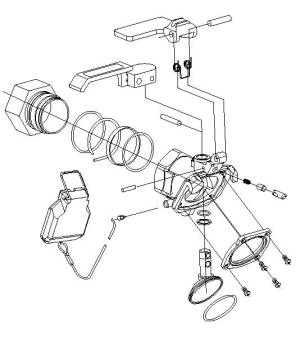 Dry Link couplings can be easily repaired or refurbished using replacement parts that can be ordered through your distributor. Our maintenance manuals and videos offer in depth instructions for restoring couplings to fully functional condition. However, situations arise where you may want us to repair your couplings. We have set up an in-house refurbish program where we can repair/refurbish your couplings. When you send us your couplings for refurbishment, we will do the following:
Dry Link couplings can be easily repaired or refurbished using replacement parts that can be ordered through your distributor. Our maintenance manuals and videos offer in depth instructions for restoring couplings to fully functional condition. However, situations arise where you may want us to repair your couplings. We have set up an in-house refurbish program where we can repair/refurbish your couplings. When you send us your couplings for refurbishment, we will do the following:
- Inspect your couplings and prepare an estimate for labor and parts. Estimate is free.
- Our estimate will consist of cost of replacement part(s) and labor to repair the couplings. Labor will include cleaning and replacing worn out parts, and pressure testing to insure couplings pass our leak test standard.
- Turnaround time would vary depending upon the quantity of couplings repaired.
- After you authorize repairs, we will then proceed with repairing the couplings.
- On repair jobs, no explicit warranty would be issued.
Applications
1. WHERE CAN I USE DRY LINK COUPLINGS?
The simple answer would be almost anywhere a hose is being used to transfer fluid, especially where no spills, drips or worker exposure can be tolerated.
2. WHAT WOULD BE THE TYPICAL DRY LINK APPLICATIONS?*
Most applications can be grouped into three functional categories
- Bulk Fluid Transfer - This includes loading and unloading of fluids from railroad tank cars, trucks, tank containers or intermediate bulk containers (IBC’s).
- Portable or Moving Equipment - This category includes a variety of different applications, such as… transfer of intermediate chemicals from one section of a plant to another via portable tanks.
- Portable pump wagons.
- Movable batch reactors (including re-circulating heating or cooling fluid in coils on the vessel wall).
- Oil connection to movable or replaceable rollers (such as on steel rolling mills).
- Fuel and lubrication connection to diesel engine test units or locomotives.
- Process equipment with heavy vibration or agitation.
- Where a feed container or trough is connected and disconnected, etc., etc.
- Switching or Redirecting Fluid Flow - This category includes applications such as…
- Manifolds for adding ingredients to stationary reaction vessels.
- Manifolds for routing finished products to various holding tanks.
- Manifolds to switch between process fluids and line cleaning or purging fluids.
- Changing colors on a paint line or pr
3. WHAT TYPES OF FLUIDS SHOULD I CONSIDER?
Really almost any fluid in a hose can benefit from Dry Link especially fluids that are hazardous, toxic, corrosive, etc. We even have applications on petroleum products and fuels, which, historically, have used lower priced aluminum hose coupling devices.
A primary target, however, should be viscous fluids that set up and harden in air. This includes epoxy resins, paints, adhesives, sealants, shampoos, etc. All competitive dry break products have a high resistance to flow and result in problems when used with viscous fluids.
4. WHAT TYPE OF PLANT WOULD NEED DRY LINK?
You would probably be surprised to learn the large number of different plants that have Dry Link installations. Most people would naturally think of truck loading at a chemical plant, but that is just scratching the surface.
Here are some typical Dry Link applications in a variety of industries:
- Chemical plants: many, many different applications including truck and rail car loading and unloading and in-plant switching manifolds.
- Pharmaceutical plants: same as above….every pharmaceutical plant is also a chemical plant…also, smaller batches mean more hose connections.
- Cosmetics: shampoos, hair colorants, liquid make-up…. many different product types and small batches.
- Adhesive manufacturing: also coatings, films and backing for carpeting.
- Paint and varnish manufacturing: many applications….solvent switching…drum filling.
- Ink manufacturing: similar to paints….also shipment to printers via IBC’s.
- Printing plants: ink receiving and transfer operations.
- Soap and detergent manufacturing: enzymes, surfactants, caustics, etc.
- Rubber and plastics manufacturing: additions, resins, acids, misc. chemicals.
- Pulp and paper: process water treatment chemicals.
- Mining: (especially liquid processes such as leading and floatation), process additives.
- Automotive: (also farm equipment and trucks) painting lines, solvents.
- Electric power: boiler and cooling tower water treatments chemicals….also, mobile transformer regeneration units.
- Railroads: refueling of locomotives.
- Wastewater treatment plants: sodium hydroxide, liquid ammonia, and specialty chemicals.
- Chemical waste hauling and incineration: spent acids and solvents.
- Fiberglass manufacturing: unloading caustic and other chemicals.
- Agricultural chemicals: manufacture and distribution of fertilizers and pesticides.
- Nuclear industry: radioactive water.
- Chemical distributors: unloading from tank trucks, blending and filling intro drums and IBC’s.
- Liquid transfer terminals: Tank farms with rail, water and truck transfer.
- Micro-electronics/circuit board manufacture: glycols, solvents, epoxy resins, and wastewater treatment.
- …….the list goes on and on………we welcome any uses you discover and wish to share with us!
5. HOW CAN I RECOGNIZE A DRY LINK APPLICATION PLANT FROM THE ROAD?
You may literally be passing by Dry Link installation as you drive down the highway:
- Lots of tanks, especially smaller sized tanks which usually means batch transfer.
- IBC’s (Intermediate Bulk Containers, or totes) usually 250 to 400 gallon capacity, especially stainless steel ones stocked in the yard.
- Intermodal tank containers.
- Tank trucks and railroad tank cars waiting to be unloaded.
- Rail or truck loading (or unloading) facilities with loading arms, access platforms, etc.
- A piping manifold with hose connections, right on the wall of the building.
* The applications listed above represent "typical" applications. Each application is unique and our couplings may not be suitable for all applications. We strongly recommend that the customer first tryout a set of our couplings for their application before purchasing large quantities. Customer assumes full responsibility for the selection of our couplings and/or materials for their application. Please read our complete Terms&Conditions/Warranty information.
Coupling Varieties
| Component | Size | Housing Material | Main Seal Material | End Connection | Special Requirements |
| Coupler (Style 250) |
½" (DN 15) ¾" (DN 20 1" (DN 25) 1 ½" (DN40) 2" (DN 50) 3" (DN 80) 4" (DN 100) |
SS 316 Alloy 20 Hastelloy C |
Fluoroelastomer (FKM, Viton®) EPDM PTFE Perfluoroelastomer (FFKM) |
NPT (female) BSPP (female) Flanged ANSI Class 150 Triclover |
Sanitary with 20 RA polished internals FDA or USP approved seals Keyed couplings Certification documentation |
| Adaptor (Style 260) |
½" (DN 15) ¾" (DN 20) 1" (DN 25) 1 ½" (DN40) 2" (DN 50) 3" (DN 80) 4" (DN 100) |
SS 316 Alloy 20 Hastelloy C |
Fluoroelastomer (FKM, Viton®) EPDM PTFE Perfluoroelastomer (FFKM) |
NPT (female) BSPP (female) Flanged ANSI Class 150 Triclover |
Sanitary with 20 RA polished internals FDA or USP approved seals Keyed couplings Certification documentation |
| Repair Parts | Please refer to maintenance manuals for ordering parts. | ||||


Technical Information
Maximum Working Pressure
| Nominal Size | Stainless 316 and Alloy 20 | Hastelloy C |
|---|---|---|
| ½" (DN 15), ¾" (DN 20) & 1" (DN 25)" | 210 psi (14.3 bar) | 210 psi (14.3 bar) |
| 1 ½" (DN 40) | 210 psi (14.3 bar) | 210 psi (14.3 bar) |
| 2" (DN 50) | 150 psi (14.3 bar) | 210 psi (14.3 bar) |
| 3" & 4" (DN 80 & DN 100) | 120 psi (8.3 bar) | 210 psi (14.3 bar) |
For one-time field test only, the maximum joint working pressure may be increased to 1 1/2 times the figures shown.
Bending Moments (coupled assembly)
Maximum 200 ft-lb. (271 n•m) at the swivel
Vacuum
Tested to 20° (711 mm) Hg vacuum in all positions without leakage
Operating temperature range
| Fluroelastomer (Viton®) or EPDM seals | -20° to +230°F (-29° to +110°C) |
| PTFE seals | +20°F to +230°F (-7 to +110°C) |
Contact Control Devices for higher or lower temperature requirements
Wetted metal parts*
| Standard | All 316 stainless steel ASTM A351, Grade CF8M |
| Optional | Alloy 20 ASTM A351, Grade CN7M |
| Optional | Hastelloy C ASTM A494, Grade CW2M |
*Disc is electroless nickel plated to reduce galling.
Seals
| Fluoroelastomer (FKM, Viton®) |
Typically used for oxidizing acids, petroleum oils, halogenated hydrocarbons, lubricants, hydraulic fluids, or organic liquids. |
| EPDM | Typically used with dilute acids, ketones, or alcohol. |
| PTFE | Typically used with most chemicals and solvents. |
| Perfluoroelastomer (FFKM/Chemraz®Kalrez®/Perlast®/Simrez®) |
Typically used for higher temperatures and for fluids that have suspended grit. |
For special applications and optional materials, please contact Control Devices.
Flow Data
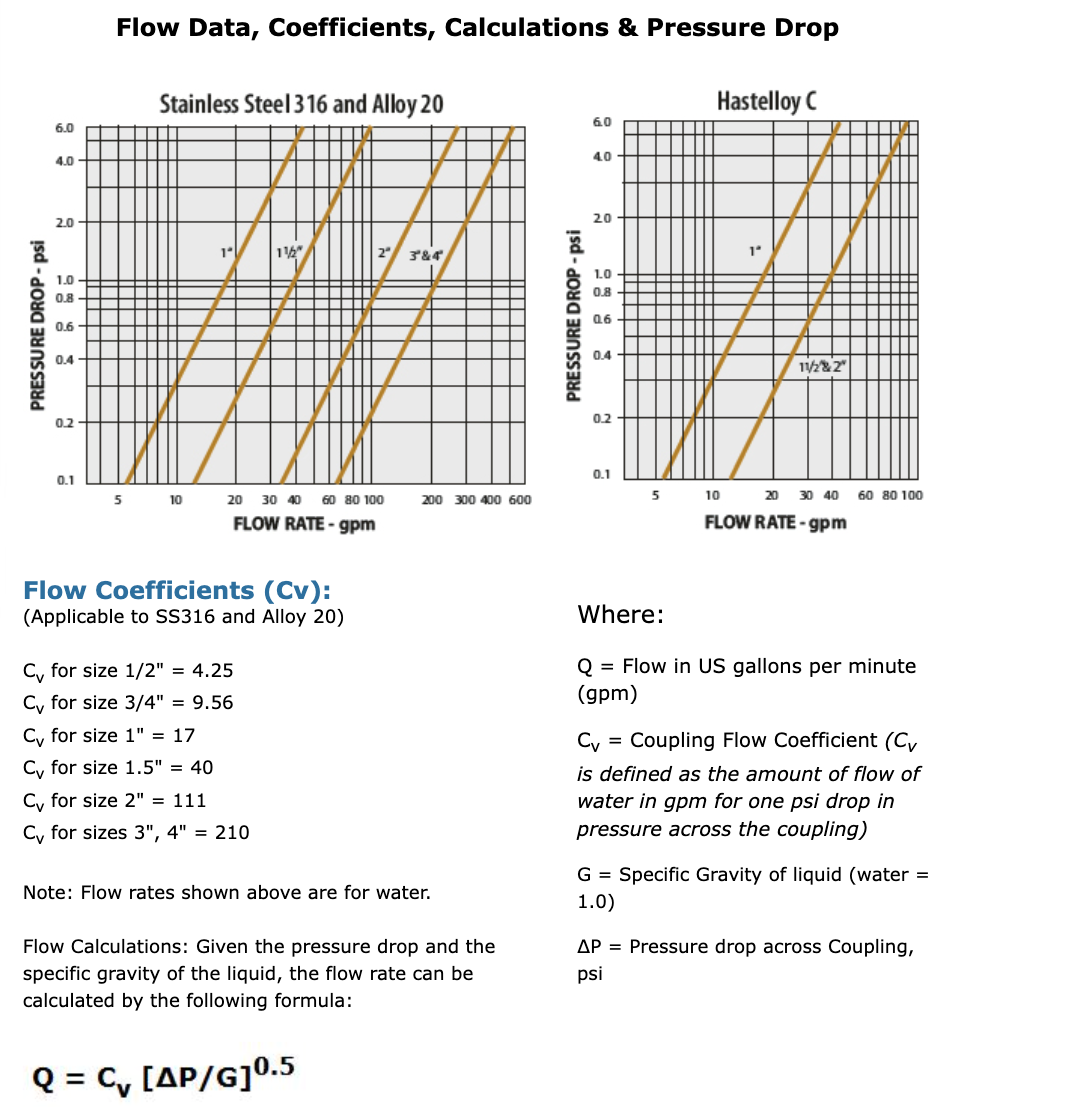
3-D Drawings
SS316 & ALLOY 20 UNITS
| 3/4", 1/2", 1" Adapter Half | 1.5" Adapter Half | 2" Adapter Half | 3" Adapter Half | 4" Adapter Half |
| 3/4", 1/2", 1" Coupler Half | 1.5" Coupler Half | 2" Coupler Half | 3" Coupler Half | 4" Coupler Half |
Hastelloy
| 3/4", 1/2", 1" Adapter Half | 1.5" Adapter Half | 2" Adapter Half |
| 3/4", 1/2", 1" Coupler Half | 1.5" Coupler Half | 2" Coupler Half |
Files
Control Devices DryLink Product Catalog
Control Devices Dry Disconnect Couplings Product Sheet
Maintenance Manual - 1 - 1 1/2" sizes
Maintenance Manual - 2", 3" & 4" sizes
Maintenance Manual - Hastelloy C Couplings
Dry Link Refurbish Program










